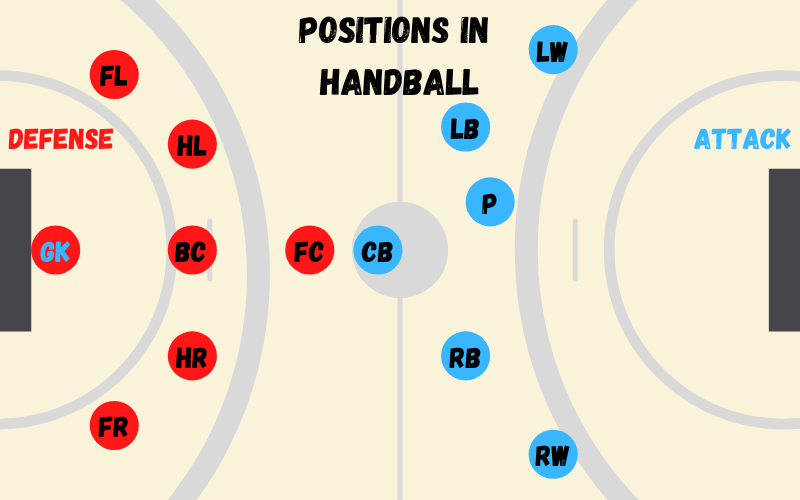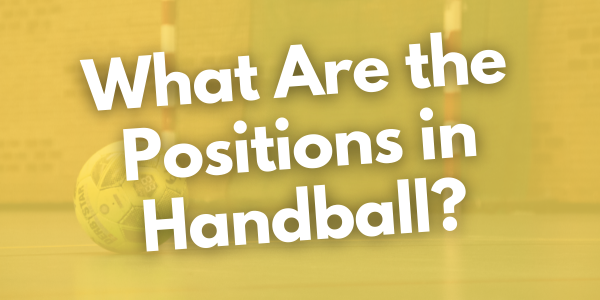Want to start playing handball? Let’s begin by learning a little about each position on a handball team. It’s a good idea to get a general understanding of the responsibilities of each position to know which suits you best.
A handball team is made up of 15 individuals. 1 goalie, 6 outfielders, and 7 substitutes. A team starts the game with 1 goalie and 6 outfield players covering 7 positions. Each position has offensive and defensive responsibilities.
Handball offensive positions are called:
- Goalkeeper
- Left Back
- Center Back or Center
- Right Back
- Left Winger
- Center Forward or Pivot, also knows as Circle Runner
- Right Winger
On defense these positions take on a different name:
- Goalkeeper
- Far-Left
- Back Center or Center
- Far-Right
- Half-Left
- Front Center
- Half-Right
Refer to the picture to see where each position is on a handball court.

Handball Goalkeeper
Even though the goalkeeper position involves the least amount of running, it’s one of the busiest positions on the team. They are the last line of defense against opposing shots.
If a goalie makes a save and the ball goes out of play over the net, the goalie keeps the ball and restarts the game with a goalkeeper throw. This pass must come from inside the goal zone (6-meter line) to a player outside of it. A goalkeeper throw can be a shot at the opponent’s net.
A save that goes out of play on the sideline results in a throw-in for the opposing team.
Also, goalkeepers can leave the goal zone and become an outfield player at any time.
In handball, goalkeepers don’t make diving saves as they do in football, and they don’t wear masts like they do in hockey. It’s one of the most demanding positions to play and is often reserved for a tall player.
Handball Left/Right Back
Left and right backs play in-between the center and the winger on offense and drop into the Half Back positions on defense.
Usually reserved for the biggest players on the team, the left and right back positions require athleticism and size as they occupy the most crowded areas on the court.
Players in these positions often spend more time passing. When they shoot, it’s usually from long range.
On defense, a Half Back is responsible for covering the net and taking away shooting chances. They always need to be ready to use their arms to block shots and passes.
Handball Center Back
A Center Back on offense and a Back Center on defense is one of the most important positions on the team. They are responsible for communicating strategies and plays to their teammates throughout the game.
This position, dubbed the playmaker, is often reserved for the most skilled player on the team. On offense, a Center Back is always thinking forward trying to set up his teammate for an open shot. On defense, they are attempting to misdirect the opposing team with movement.
Similar to the Half Back positing, the center back has to use their size to block shooting lanes and deflect passes.
Handball Center Forward or Pivot, also knows as Circle Runner
The center forward position is best suited for the most agile player on the team. As the main attacking force, the circle runner is always in motion searching for a shooting opportunity. Always regarded as the shooter, the player in this position needs a strong and accurate arm.
Sometimes referred to as the pivot, the center forward is often involved in give-and-go plays between themselves and all the other attacking players. Many plays orchestrated by an offense end with the Center Forward taking the shot.
The defensive duties as a circle runner are clogging up open space between the 8-meter line and half-court and attempting to steal the ball.
Handball Wingers
Usually the fastest runners on the team, the wingers are responsible for maintaining control over their side of the court. Wingers spend most of the game sprinting up and down the sidelines, playing strategic passes to players in shooting positions.
It’s common for wingers to take sharp leaping jumps into the goal zone as they attempt to create better angles for their shots. For that reason, Right Wingers tend to be lefthanded and Left Wingers dominant with their right hand.
On defense a winger tries to intercept passes between the opposing teams wing players and use their bodies to block shots from their respective side.
Substitutes
Each handball team can have up to 7 substitutes. A sub doesn’t have to wait for a stoppage in play, it can happen at any time. Before a new player enter the court, the player subbing out must leave the playing filed entirely.
There are no limits to how many substitutions can take place in one game, so it’s common to see teams swap out tired players for fresh ones throughout the whole game.
Want to Know More About Handball?
If you want to learn all the rules of the game, I’ve put together an article with everything you need to know. It’s called Handball Rules, How to Play Handball. The guide is equipped with a bullet point list of all the rules you need to know to play the game. Regardless of if you play indoors or at a beach, the same rules apply.
There, you’ll find a downloadable PDF of all the rules and regulations. Feel free to download my guide and share it with your teammate and organization.
Keep playing this amazing game, and always remember to be competitive and have fun.
